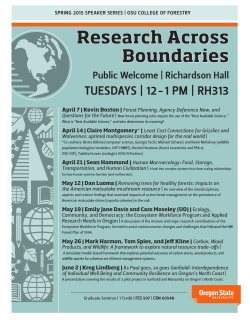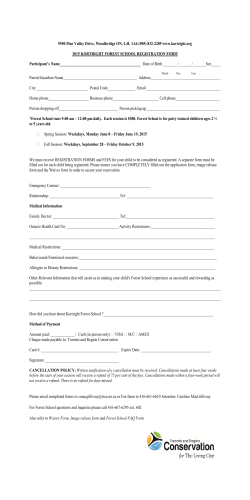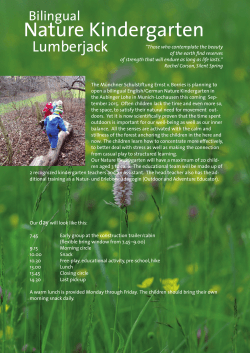
Calibrating Teaching to Achieve Community
AAE 2014 CONFERENCE PROCEEDINGS SYMPOSIA Hyalite Pavilion – Calibrating Teaching to Achieve Community Effectiveness Bruce Wrightsman Kansas State University Introduction Hyalite Pavilion Hyalite pavilion is located along the Hyalite Reservoir in the Gallatin National Forest 16 miles south of Bozeman, Montana. The new pavilion serves a vital public need for covered recreational and social activities at a key leisure spot within a popular day-use area. Hyalite pavilion is an award winning collaborative ’live’ project that connected a team of faculty and architecture students with the U.S. Forest Service and multiple community business partners. The project consisted of the design and construction of a public multi-use pavilion located in a popular recreation area within a designated National Forest context. A research / teaching strategy was calibrated to address the physical challenges of extreme climate, and remoteness of the mountainous site as well as the complex public/private collaboration formed to complete the project. The pedagogical objective of the Hyalite Pavilion project is to be a laboratory for teaching and learning, providing students a unique educational opportunity to conceive and test design ideas in real time and at a one-to-one scale. Students develop an ethos of making through a physical engagement of materials and methods. As a design / build project, the key challenge for students is working with limitations that rarely if ever are addressed in a typical design studio. This paper will share many of the challenges learned from the Hyalite Pavilion project. The success and learning opportunities presented will come from the academic assessment of the completed work and on-going research with the community partners. It hopes to elucidate the value and challenges of a highly successful ‘live’ project from both academic pedagogical and community viewpoints. Partnership The initial desire for the pavilion and the partnership with Montana State University (MSU) came from the Gallatin National Forest office in Bozeman, MT who believed a partnership with the School of Architecture at Montana State to design and build a pavilion structure would be mutually beneficial. They contacted the MSU-School of Architecture directly where the administration enthusiastically embraced the academic opportunity. The design goal would be to reinforce the positive image of the Forest Service as good stewards and conservationists. Visiting Hyalite Pavilion would help people understand the forces of ecology and the nature of the forest landscape through the architecture. Research Methodology One way design faculty sometimes frame ‘live’ projects is as participatory action research, which has been well defined in the engagement literature 1 of education. Following the assertion that participatory action research should involve a reciprocal sharing of knowledge and should include an evaluative process of “reflective dialogue” with 2 stakeholder the author interviewed a key community partner. The author coded the interviews for four initial themes: project organization or timeline; liability and responsibility of outcome; federal, state and local regulations; and fees, budget, and financing. Of these, the responses from the Gallatin National Forest client emphasized liability and responsibility of outcome; as well as federal, state regulations. In addition, emergent or unexpected themes in the stakeholder interview included the social engagement challenges and accepting skill limitations of working with college students. Working within Federal Design Standards The intent of architecture to fit harmoniously within a national forest context has its roots in the founding of the United States Forest Service. The agency’s successful history includes many of the beautifully handcrafted and sensitively designed rustic structures of the Civilian Conservation Corps era that are still admired today. The agency’s aspiration is to ensure thoughtful design and management of the built environment and to promote the principles of sustainability. These goals are consistent with the agency role as a 165 AAE 2014 CONFERENCE PROCEEDINGS SYMPOSIA leader in land stewardship. Current U.S. Forest Service design should aspire to synthesize rustic style precedents with contemporary realities and needs. The ongoing design goals of the U.S. Forest Service are documented in the Building Environmental Image Guide (BEIG), which all districts of the Forest Service use for facility design. The challenge for the architecture students was to create a structure sensitive to the natural mountain forest and lake context, while assessing the (BEIG). B.E.I.G. (Building Environmental Image Guide) Calibrating an Academic Community Expectations Schedule with The site’s region receives significant winter precipitation limiting the construction time available to build. Coupled with the remoteness of the site and the material and equipment procurement challenges from working with a federal agency, a hybrid solution of off-site prefabrication and site-built strategies was developed. This required a unique research and teaching strategy calibrated to address the challenges of completing the work. The planning, design and construction of the pavilion spanned six semesters. The project was organized into a series of iterative experiments beginning in a research phase to develop a design strategy, (Figure 1). Subsequent steps included creating a concept, fabricating prototypes of the prefabricated components, and then re-testing again on site before the project was redesigned for final construction. The prototyping was a mutable activity serving as a feedback loop, which allowed for thoughtful deliberation and imaginative engagement vital to the learning objectives of the class. The Building Environmental Image Guide addresses three contexts—ecological, cultural, and economic, which can take many forms. The United States Forest Service region in which the building is located informs the designer how that context should be viewed. Hyalite Reservoir is located in Rocky Mountain Region covering the glaciated terrain of northern Idaho, of western Montana and eastern Washington. Rugged mountains, prairieland, coniferous forests, and alpine meadows define the region. Winters are typically harsh. Most definitions of the word “image” include “appearances” or “physical representations” of objects, places, or people. The public image of the U.S. Forest Service is based upon people’s perception, so the creation of a positive image for the built environment is essential. The research phase critically investigated the physical and environmental aspects of the day-use site. The goal of the research was to provide foundational information of the site, its context, and its value assessment for future design work. “To many people, the rustic imagery of the CCC era remains the most positive image for the built environment of the Forest Service. Perhaps this image remains popular because of its strong relation to the natural, cultural, and economic contexts; its reflections of a frontier past; and the 3 humanizing aspects of handcrafted buildings. “ The BEIG, coins the term “rustic architecture” to describe a desired style or characteristic of many Forest Service regions. It is based upon a canny combination of pioneer building skills and techniques, principles of the Arts and Crafts movement, and the premise of harmony with the landscape. The BEIG captures and codify the prevailing design attitude that had been practiced for many decades in natural settings. The guide attempts to define “rustic architecture” as unified vision for the appropriate built environment image for each Forest Service region. Figure 1. Hyalite Pavilion project schedule The analysis included an assessment of the physical, environmental and experiential aspects of the site and immediate reservoir area. Included were observations of current activities and uses at the reservoir area, a projection of how these activities would be impacted, and potential new activities to introduce. The design phase began in the spring 2009 semester. The collaborative partnership between Montana State University, School of Architecture and the Gallatin National Forest expanded to include business partnerships The BEIG, however, is more than a guide on style and appearance. The notion of ‘rustic architecture’ formulates the premise of creating harmony with the landscape. The value of the BEIG is that it challenges designers to understand skillfully the physical and intrinsic characteristics of a regional site. In the sensitive contexts of the U.S. Forest Service the challenge of using such guides becomes assessing the differing perceptions of the region and place. 166 AAE 2014 CONFERENCE PROCEEDINGS SYMPOSIA discovered new ways to communicate effectively how the design complied with BEIG. with a local structural engineer and a stone masonry company in Big Fork, Montana, which sponsored the design phase of the project. Through a series of design charrettes, two primary strategies emerged and were presented to the Gallatin National Forest. The final hybrid design solution incorporated the strongest solutions that best addressed the issues of site, material appropriateness, flexibility of use and wheelchair accessibility. Through both the design and construction processes students were actively engaged with structural and geotechnical engineers, material consultants, as well as U.S. Forest Service engineers and rangers. Liability and Responsibility of Outcome Knowing how to build is a matter of science and technology, but knowing what to build is a question of morality, ethics, and aesthetic responsibility. Hands-on learning approaches in academic settings place a responsibility on students to participate actively as contributors to the learning environment. Projects such as Hyalite Pavilion allow students to engage architecture at real scale using real materials and learn the realities of gravity and the abilities of the craftsman as very different from their own. The Gallatin National Forest funded the $42,000 project through a Capital Investment Program grant awarded through the federal government. The complete project included five community partners and 27 graduate and undergraduate students. Working with a federal agency such as the U.S. Forest Service required careful agreement on the management of responsibility and liability. A Challenge Cost-Share agreement was developed between Montana State University and the Gallatin National Forest district that clearly denoted the mutual benefits, interests and responsibilities of both parties. To get the Cost-Share agreement through the legal and bureaucratic process at both Federal and State levels proved an enormous challenge that delayed the start of construction. The agreement also required different expectations from a traditional building project approach. The Gallatin National Forest accepted the reality of architecture student work limitations and the fact that they are not professional builders. To meet their responsibility for the management of the public structure with satisfactory construction quality, parts of the project needed to be completed by sub-contractors at additional expense. This necessitated allowing time in the schedule for assessment and modification to occur which resulted in an undefined completion date. Client Perception The academic value of ‘live’ projects like Hyalite Pavilion has been vetted through academic papers, symposia and design awards. The Hyalite Pavilion project won numerous design and teaching awards. The real value of experiential learning practices from the perspective of the community and client, however, should also be clearly considered. Do the Gallatin National Forest and community define the Hyalite Pavilion project as successful? What can we learn about ‘live’ projects from the other stakeholders? One the greatest challenges from the Gallatin National Forest Service’s perspective was overcoming some internal negativism towards the partnership with MSU. The partnership required a very different design approach from typical building projects completed by U.S. Forest Service architects and engineers. Aesthetic responsibility vs. client expectation The Hyalite Pavilion is project is unique from traditional design approaches where design changes and adaptations are easier to address. From the client perspective it was “a discovery of design”. The slow deliberative process extended the architectural potential in a highly sensitive national forest context that remains consistent with the U.S. Forest Service’s aspirations as land stewards. The potent fear, ”How do I make this?” is often tested in the learning experience of live projects. Yet, the more difficult challenge for students often is addressing the ethical and aesthetic responsibility of the designer. The challenge for the students designing Hyalite Pavilion was how to interpret the images and intent of the BEIG in ways the Forest Service client could approve the design for BEIG agreement. Initially the design was not well received by the Gallatin National Forest engineers and rangers because it did not fit the familiar imagery of previous U.S. Forest Service projects. The two perceptions of the BEIG appeared divergent. While frustrating for the students, reflecting on the dichotomy of perceptions provided a valuable learning opportunity for them. Facilitated reflection challenged beliefs, asked deeper questions, and Assessment An unexpected challenge in this complex multisemester ‘live’ project was the relationship dynamics of the architecture students. While common in traditional practice, the development of a unified group design can be problematic for students accustomed to individual design in architectural curricula. The U.S. Forest Service client commented how they were surprised to see elements of student factions occur during the 167 AAE 2014 CONFERENCE PROCEEDINGS SYMPOSIA design process. The openness to discussion and strong communication by the faculty-in-charge and leaders from the Gallatin National Forest district helped navigate the student – client relationship through design roadblocks to support of the final design solution. The Hyalite Pavilion project provided an exceptional opportunity for architectural education and life lessons for the students that demonstrate three learning benefits of going live. First, work with a real world client gives students the opportunity to be immersed in the community. Second, they experience the reciprocity of people and place. Third, the students construct their learning environment in the real world where decisions have consequences. References 1 Kemmis, S. & Wilkinson, M. 1998, “Participatory action research and the study of practice”, in B Atweh, S Kemmis & P Weeks (eds), Action research in practice: partnerships for social justice in education, Routledge, London, pp. 2136 2 Scott, D. & Weeks, P. “Action research as reflective collaboration”, in B Atweh, S Kemmis & P Weeks (eds), Action research in practice: partnerships for social justice in education, Routledge, London, pp. 241-259 3 168 Chapter 2, Building Environmental Image Guide
© Copyright 2026









